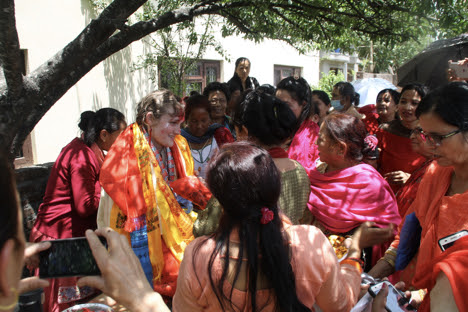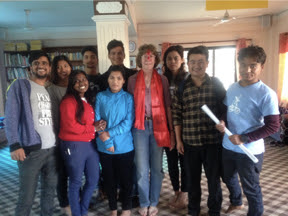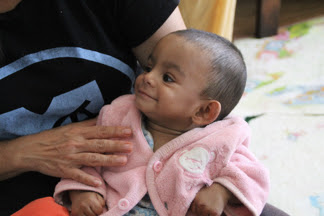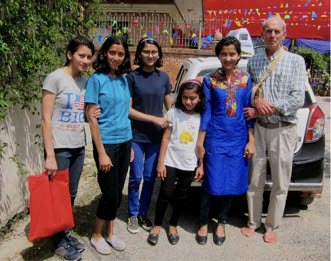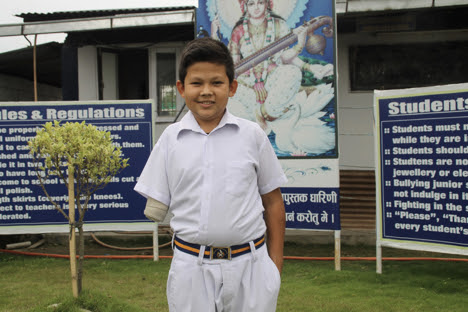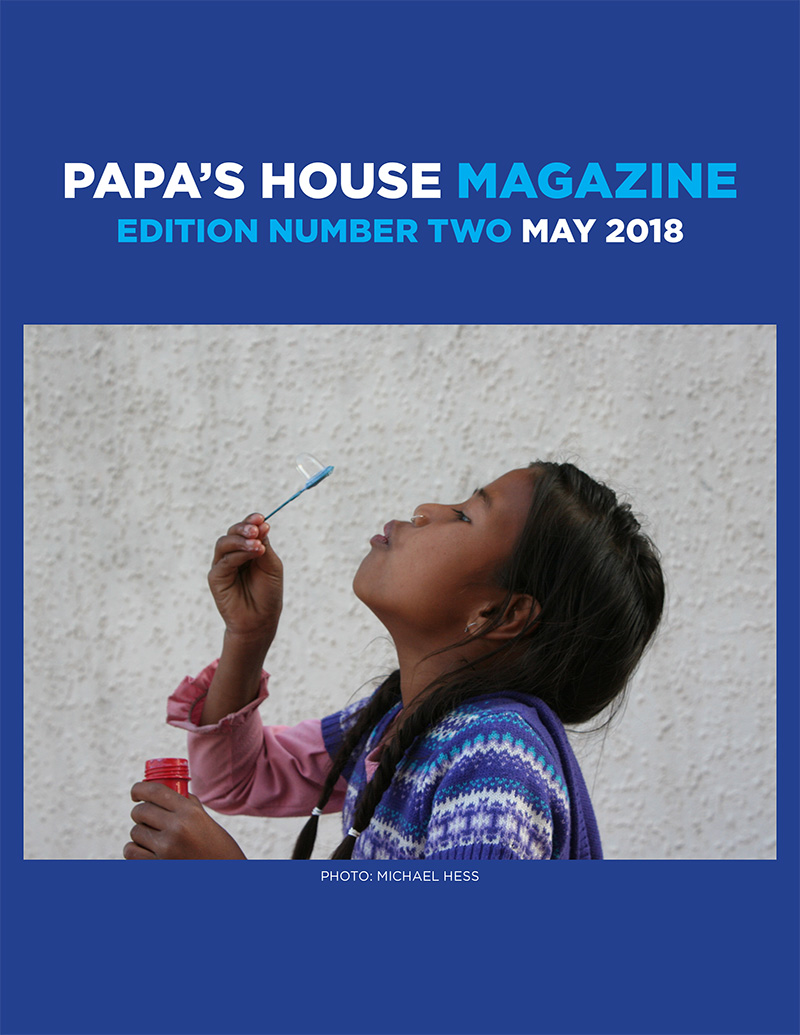January 2020
On Sunday, February 1, 2004 a 51-year-old experiencing the world beyond America for the first time in his life arrived in Nepal. He had prepared for this moment for the past year by slowly withdrawing from society, beyond his family, and looking inward to sift through his life and pack it away in hope of arriving in Nepal as empty a vessel as possible.
Here is an attempt to sum up the past 16 years. The years have been good, that much comes easy to this report. This morning as I write we have 32 of our children attending a picnic, 14 more from class 10 at school in an exam prep course, 57 children at college, 11 children in 4 different countries in work/study programs, several here in Dhapasi as full time staff, and approximately 30 more children who have married and are living mostly back in the villages of their husbands, and who have provided NOH with around 9 grandchildren.
And so, let us look back over the years.
2004: February
Arrived in Trisoli, a small and remote village as a volunteer. It profoundly changed my life and I knew before leaving that I would return to Nepal. This I managed to do by late June.


2004: August
Returned to Nepal and settled in Kathmandu.
Took over management of a home with 26 children living in miserable conditions. The children did not attend school, but rather were required to panhandle for money and food. They were sick, malnourished, and ridden with scabies and other skin conditions. They also smiled with a radiance like I had not seen before.
 |
 |
| The children and a few of the “guardians” of the home | The amazing Chham |
2004: Christmas
By Christmas our 26 children had grown to 37.


For Christmas the children received a metal box filled with gifts, practical and fun as well.
2005
By spring of 2005 we had 50 children in the home. Known locally as “Papa’s House” We sent them all to an English Medium school. While the children were at school we began a free school in our home with close to 60 village children who I had noticed were playing in the streets during the day.
2005: January poor village children attending our new free school.


2005: March rapid growth of our free school after receiving a sizeable Christmas donation.


2005: April our children in the morning ready to walk to their new school.


2006
My older brother Peter and his wife Boo came for a visit. They were moved by the children and our small village school. They also recognized the need for us to become a registered charity in the states. Boo took this challenge on and in August of 2007 NOH was incorporated in North Carolina. The first NOH Annual Report was for the year 2006. In February 2008, NOH received its 501(c)3 status from IRS, which was retroactive from August 29, 2005, which meant earlier donations to NOH from that date were tax deductible. The Board of Directors was created with Peter as President and Boo as Treasurer. The other board members were made up of friends and family who were very involved in the work we were doing.
Each year our operations expanded to help more children. In 2006 Papa’s House moved to a new, larger building to accommodate the growing family. Our school, Papa’s Trinity Academy, enabled more than 200 more children from the community to attend for free.


Our Papa’s Trinity Academy’s new home where our children also lived. Our dedicated teachers.


A morning assembly at PTA and some of our older children who attended the Science Lab School.
2006: Christmas
 |
 |
| Our Family on a cold Christmas morning | Gift giving Christmas |
 |
 |
| First Christmas for some, third for others. | |
2007
In 2007 NOH was asked to take over a nearby destitute orphanage with a dozen children. Another building was leased in Dhapasi for a second Papa’s House and additional staff were hired. Papa’s Trinity Academy leased a new building for its school as the enrollment had grown to over 340 children, the vast majority attending for free.
 |
 |
| Children we took in | Expanded teaching staff |
NOH began a collaboration with Society Welfare Action Nepal (SWAN), a Nepali nongovernmental organization operating in the Dang district, some 12 hours away by bus, to rescue Kamlari girls from indentured servitude. NOH renovated two buildings in a tiny village called Narti and opened the Lawajuni (New Beginning) Home, providing shelter, food, clothing, schooling, and health care for girls rescued by SWAN. Over the year more than 60 girls who had been sold into slavery came to the Lawajuni Home, gaining their freedom, recovering their childhoods and attending school. NOH was able to bring 12 of these girls to Dhapasi, raising the number of children provided for in Papa’s Dhapasi Houses to 70.


The two homes
Within one year of opening we had 100 girls rescued and living here. In 2007 we brought twelve to Dhapasi. The first of many to come in the following years.




Just some of the first girls to be rescued from indentured servitude
2008
In 2008, concerns with the management and direction of Papa’s Trinity Academy forced NOH to cease its support of the school. The children of Papa’s House began to attend the Skylark School, an English-medium private school in Dhapasi. NOH then initiated support of two schools in remote villages in the Ramechhap district, the Shree Sham primary school in Dumrikharka and the Mudkeswori primary school in Votetar, funding hot lunch programs and contributing to teacher salaries and school supplies for over 140 children, most of whom are Dalits (untouchables).


This is the Shree Shram School in Ramechhap in April for the New Years beginning session.
Both schools suffered from a lack of attendance. We provided the hot lunch program as an incentive for the children to attend, as well as the supplies necessary for them to benefit in class.






The Mudkeswori School where we began the same program for the children’s education.
In addition to our educational support in the remote village of Dumrikhaka we also began a women’s collective for the village.
There were several environmental issues that severely diminished the quality of life there. Cooking was done indoors without ventilation over fires of twigs, brush, and trash. The land surrounding the village was simply an open container for debris. With the help of FoST, a Kathmandu NGO striving to raise awareness in environmental health and sustainable technologies, NOH introduced a system to make virtually smokeless briquettes for cooking, and in addition retrofitted the interior clay stoves with ventilation. The debris and trash casually spread everywhere was the primary source for these briquettes. The incentive for doing this was two pronged, first to increase the health of the people and environment and secondly to allow the women’s collective to begin selling these briquettes to other villages for income.




2009
In early 2009, NOH brought another 26 rescued Kamlari girls from Lawajuni to Dhapasi, where the education was significantly better. We opened a third home, known as Papa’s Kalpana (Imagine) House. The girls moved into the building originally housing our boys, who relocated to a newly expanded and renovated home on the same grounds, Papa’s Sambhav Possibilities) House for boys. Later in the same year, 28 more girls rescued by SWAN (Society Action Welfare Nepal) came from our Lawajuni homes to live in NOH’s fourth and newest home, Papa’s Gumba (Sanctuary) House.
A truly wonderful event occurred in early 2009 when one of our Volunteers happened to be creating a website for Sanctuary for Children. The founders, Amanda Tapping and Jill Bodie, learned about us and decided to visit. Sanctuary for Children (S4K) had recently formed and owing to Amanda and Jill’s celebrity recognition in the film industry it garnered a multitude of fans in support of their mission to help children.
 |
 |
| Amanda surrounded by some of the children | Jill with a couple of our older girls |
 |
 |
The support from Sanctuary for Kids, which was to last for eight years when they closed S4K and dispersed the balance of funds to a number of organizations like ours, allowed us in 2009 to open our new Sanctuary House and bring an additional 28 rescued Kamlari to live with us in Dhapasi.


Above and below some of our new children who arrived in 2009.




2010
By 2010 NOH was operating four homes in Dhapasi, all within a short walking distance of each other. Over half of the children then provided for in Papa’s Houses were rescued Kamlari girls.


Welcoming new girls and boys
 |
 |
| The boys came when their orphanage was closed | These girls were brought from Lawajuni |
NOH also began supporting three more outreach programs in 2010. The Bigu Nuns Monastery, a school for Sherpa children, and some additional local community support, from medical to educational.


Bigu Nuns’ Monastery


Sherpa School
Since 2005, NOH has also operated a volunteer program. With placements in reputable NGO’s and local community projects, Volunteer Nepal grew steadily by way of the testimony’s volunteers took back home with them. They described life-changing experiences with us and felt they had received more than promised in every aspect. The income from Volunteer Nepal helped provide revenue for our expenses and support for local organizations allowing us to expand both our outreach programs and the care for our growing family. Volunteer Nepal continues to this day.

Papa’s House Children in 2010
2011
2011 began with 113 children, 86 girls and 27 boys.
Additional community support in 2011included a local outreach. NOH paid weekly visits and provided medical intervention and nutritional support for mothers and children in a neglected slum in Kathmandu known as Dalu.






At home the children were learning to prepare, grow, and cultivate vegetables.


As well as cultivating a crop of great perfomances at school.


 |
 |
 |
| Ishwor 86.22% | Samjhana 100% | Srijana 95% |
 |
 |
 |
 |
| Apsara 93% | Rupa 94% | Khusbu 94.83% | Sita 91.56% |
 |
 |
 |
| Kamal 82.5% | Sangita 93% | Kanchi 99% |
 |
 |
 |
| Sumitra 88.4% | Asha 90.88% | Anisha 88.8% |
And this year the first of our children to begin college.

It was an early, rainy, August morning when all the children walked together with Hikmat to his first day of college.
Christmas Morning 2011

2012
A fifth home, Indreni (Rainbow) House, was opened in early 2012. A total of 124 children now resided in Papa’s House’s. Even with all the growth, one constant has been the exceptional care our children receive. Papa’s House children are secure, happy members of a loving family.
Adding the Indreni House required us to Home School for one year the children who would be sitting there. Mrs. Sunita Pandey who is now our Director of Papa’s House was the sole teacher for them all. Her task would be with teaching them English and grade level subjects in order that they could attend the Skylark School the following year. These children ranged had little formal education and spoke the language of their villages.


We created uniforms for the children for their homeschool.
2013
2013 began with 135 children, 9 of them in college.
Maintaining all of our Outreach programs we continued to serve local needs as best we could. We raised the money to help a dying 16-year-old boy receive a new kidney, and care for him and his family for 1 year. Today he greets us each morning when he brings his son to Skylark school.

The donated kidney came from his mom. With operation supplies he waits.
NOH opened an after-school Vocational Training Center. Classes were held in Computer Hardware and Software, Guitar, Voice, and Harmonium, Tailoring, Beauty Salon, Motorcycle Repair, and Mobile Phone Repair.









NOH added to their list of Outreach Programs by beginning support of the Gholdunga Home for the Blind.
Money for rent, food, and salary for management was provided. All the children had exhaustive eye exams and as a result one young teenage girl had a corneal transplant.


The children and the home as we found them in 2013.


Just recently at Papa’s House we celebrated some of the holding children’s birthdays.
But the greatest event of the year occurred on August 8th, when we brought Hope Angel home from the hospital. Only 13 weeks old and twice having battled back from death. Hope is our Jedi Warrior, and my inspiration to be a better person.
From an Update in 2013, excerpts from a letter to my cousin Anne.
Our precious little girl has been named Hope following your suggestion, but I have heard many of our smaller children whisper to her ‘Angel’, as if they know something. She has found a way to touch each of our hearts in exactly the way we did not know we needed them touched. Hope radiates love and courage; watching some of our older girls talk to her, feed her and hold her with such beatific smiles in the darkening evening’s golden hues is priceless.
Our family has closed around Hope like we do all our children. A new child arrives and their heart beats out of synch; they are feeling alone, afraid, and then the children draw them in and the pain that has brought them here evaporates, and within a few hours they smile as their heart becomes part of the collective beat of all the children.
This evening with her new Mom Anita radiating love upon her, Hope lay on the bed and surveyed all her sisters cooing over her, she gave a crooked smile, took a deep breath and went to sleep. She had had a long day.
Hope is our family’s finest gift ever; the road ahead will not be easy, but it will be paved in love with all our children sharing her battles. One day the unique spirit of Hope’s will be known to many. Little Hope has a big destiny ahead.



Hope today with her Dad, Sam

Meeting friends

And with Mom, Anita
2014
2014 began with 141 children. There were 16 children in college.
 |
 |
| Some of the college children | Cila won a full basketball scholarship |
Our Chelsea Education and Community Center began teaching local women during the daytime. They came to learn English, simple math to help them with their small shops, and some to learn to read and write.
 |
 |
| The women arriving early for school | Tilak and his first shoe |
In the afternoon classes we added a course in Shoe Making which resulted in our children opening Papa’s Shoe Shop which provided the kids an income and us all of our school shoes. The children also made shoes for some other school children and a few of the homes that we support.
We opened Hope’s Café at the Skylark School in order to provide our children with a hot and nutritious lunch and to well over 100 other Skylark children.
 |
 |
| Children in front of Hope’s Café at lunch time | Hope |
Our Outreach Programs expanded to include the EDUC School which provides a good education for children of street vendors. Kanti Children’s Hospital Oncology unit to provide medicine and grant final wishes to the children there whose parents are destitute and cannot provide the medicines themselves. Om’s House, a small orphanage that cares for children with disabilities, and OCPF a small orphanage near us. We also extended more support to local families in great need. Hope’s Fund was established to provide primarily medical support or living support to those with disabilities.
 |
 |
| EDUC | Kanti Children’s Hospital |
 |
 |
| Om’s House | OCPF |
 |
 |
| Local families in need | It was a great year of service and Hope |
2015
2015 Began with 136 children. 25 of them in college.
This was a most uncommon year, with two devastating earthquakes; political strikes resulting in months of severe shortages of petrol, cooking gas, food supplies; but it was also a good year too.
January
Our Education and Community Center purchased 36 laptops and began a Math curriculum using Khan Academy online.
Board Member Ted Seymour guided this programs construction with help from Emily Gabbard a Math whiz who volunteered with us.
 |
 |
 |
 |
| Ted and Emily with some students | Binod, one of our math teachers |
February

Our first purchased home. The boys moved in.
February 14th
At the annual Valentines Day Celebration at Skylark Anita was on one side in front of the stage watching with Hope while I was on the opposite side taking photos. Suddenly Hope left Anita’s arms, walking solo for the first time and she came towards me landing and laughing in my outstretched arms. A marathon first walk distance. A walk that will never be forgotten. Others with camera’s caught it on film for us.


March

We opened the Papa’s House Tailoring Shop, owned and managed by our girls.
April
The school year ended in April with 14 of our children scoring between 1st and 3rd in their classes.
 |
 |
| Ranked second in their classes | Ranked third in their classes |

Ranked first in their class
April 18th
One Billion (Girls) Rising came to Dhapasi


April 25th


Just before noon a 7.8 magnitude earthquake would change our lives forever. 9000 people dead, 22,000 people injured.
That same afternoon our children began a clean-up, while neighbors sat huddled in the middle of our grounds, far away from structures, too much in shock to do anything.
By the next day NOH organized its Volunteer Nepal department to go to remote villages that we supported and bring blankets, money and other supplies. The journeys were difficult because of landslides, and the destruction so widespread, but our staff made it through, and they were often the first people to reach those in need.
Aftershocks in the high 6’s were frequent. Our kids showed great strength, and adaptability to living without many things, and prevailing fear among the general population. The children’s support for one another was very touching. We refused to sit around paralyzed like most and each day we strived to bring more order with the clean-up and attempts to resume normalcy.


April 30th
Hope’s Birthday!

We decided to celebrate it well.
May 2nd

We welcomed new children, sister and brother Samita and Sanjeev.
May 11th
A second earthquake. 7.3 magnitude. Our neighborhood below.




The second earthquake opened fresh wounds, so we doubled down on arranging picnics and fashion shows, sports days, and other fun activities and made adventure from the shortages.









August 13th
Another new child arrived. She is from Gorkha, a remote mountainous region that was devastated by the earthquake and had lost her family.
 |
 |
| Sarita in front, day of arrival | Same day, flashing the peace sign |
July and through the rest of the year. Political strife closed our southern border which resulted in severe shortages in petrol, food supplies, cooking gas, all transported goods and goods from India. The Chinese border remained closed due to the earthquake’s landslides. As fall came on the electric was reduced to 8-10 hours per day.
2015 was a year to remember, for it taught each of us about our personal strength, and the power of love for your family.
2016
We began the year with 132 children (39 in college).
This year was notable for the hard work and support that our Outreach Program provided.
Donations poured in as a result of last year’s two earthquakes, allowing us to assist many communities, organizations, and families.
Earthquake rebuilding support was given to
- Mother Sister Nepal, an orphanage opened in a remote area to house children orphaned by the earthquake.


- The total cost of building a new school at the Dumrikhaka Village that we have supported for many years.


- The Bigu Buddhist Nuns’ Monastery.




- A boy’s home in Charikot, part of the Bal Mandir network of 9 Children’s Homes.


- Chaturali Village Medical Clinic.
- Home and School in Ghorka, a remote mountain region devastated by the quakes.
- Home in Trisoli.
- Several families homes in our own community.
- The home of our Tutung Volunteer Host family.




In April we welcomed Ranjana into our home.
In May we sent two of our older boys to bring rescue supplies to a Chepong Community of 29 families that had no food and were living on nettle soup.


In June we took hope to Boston in order to have her first operation and to be fitted with state-of-the-art prosthetics.


In August we broke ground on our new Education and Community Center. Early in 2016 NOH President Peter Hess submitted a proposal in response to a request from a Swiss Charity organization. Peter wrote a compelling work outlining the benefit to NOH and the Dhapasi Community if we were able to build a new Center and the grant was approved.

The new center was built on the grounds of our Boy’s Possibilities House
Meanwhile all our other Outreach Programs continued unabated.


2017
2017 began with 132 children, 44 of whom are in college.
In the summer of 2017, following board meetings in Dhapasi, the NOH Board of Directors approved the Strategic Vision of Nepal Orphans Home. In the fall the in-country operations of Nepal Orphans Home become the Papa’s House Nongovernmental Organization (NGO), rather than an International Nongovernmental Organization (INGO).
All the children, from our youngest Hope Angel at four years, to those now hitting twenty-five and older, have had personal breakthrough moments, epiphanies of both mind and soul, catalyzed by situations good or challenging, as they continue to develop character and skills ahead of their ages. Profound moments of realization for the individual and joyful moments for the rest of us to share with them.
Five of our boys won scholarships to a college noted for its basketball program. Bimal has turned his years’ worth of Saturday morning art instruction by a kind College of Fine Arts instructor, into some captivating and technically advanced paintings in his own style, which he has been selling to very appreciative viewers.
Urmila won a full scholarship and placed first out of hundreds taking an admission test to Kantipur Dental College; four of our nine advanced Taekwondo students tested and won their Black Belts; the others have not yet tested due to time conflicts but will soon.
 |
 |
| Our first black belt holders | Bimal, the artist |
 |
 |
| Urmila in 2017 | and on right in 2007 at our Lawajuni Home |
In less obvious fronts we have witnessed the graceful transition of those leaving their teen years and displaying the best of adulthood in how they balance college, work, friends, group living, independence and inter-dependence, maintaining their individuality, and growing even more confident in themselves and their choices for a future.
There are few rewards as fulfilling as sharing the evolution of your children from bundles of energy living in the moment, whose attention span is as brief as a butterfly, to young adults full of quiet conviction and a desire to return to you their thanks for always being there for them.
The NOH Business Incubator program helped our sons Ashok and Dhiraj open the “Brothers’ Café” on the grounds of Skylark School. With a student body of over 500 non-NOH students, half of which have the means to buy a good lunch, and over thirty teachers wishing for a variety to choose from for their mid-day meal, we felt this to be a perfectly positioned location for the Brothers to begin their dream.
 |
 |
| 2017 | 2007 Ashok 4th from the left, Dhiraj far right |
Ashok, on the left, finished three years of college, has taught the adult women at our Chelsea Center for two years, and is a member of the Papa’s House Board of Directors. He recently received a scholarship at Thames College to study IT and has finished one half of a three-year program.
Dhiraj, on the right, has always excelled academically and has helped to develop some of the computer programs taught at the Chelsea Center. He has finished two years of college in Science and is taking a year off to contemplate his future while getting his TOFEL certificate, and exploring opportunities in Medicine, or IT. As an update, Dhiraj will graduate from an IT college in Australia in February 2021. He works very hard and supports himself entirely.
In April the completed Chelsea Education and Community Center was officially opened.
 |
 |
| The newly completed CECC | An American Embassy Rep and Peter Hess, President of Nepal Orphans Home |
 |
 |
Dedication speech by Mr. Roger Biggs representing the Charitable Foundation that provided the grant. And on the right, local woman filling the main hall of the new CECC.
2018
We began the year with 125 Children 51 of them in college.
NOH spent the year in reflection and considering what if any changes we wish to make going forward. A new Director of NOH was named, Mrs. Sunita Pandey who already had seven years working for us while serving in every department.
In our Outreach Program we continued our care for all the existing programs but informed several that the funding was going to be reduced in 2018, and then again in 2019. We increased our local support for individuals and families in need, and we increased our support for the babies at Bal Mandir Orphanage.
 |
 |
| One of the babies at Bal Mandir | A young boy we took to the Jaipur Clinic in India |
NOH enrolled nine of our college students into an apprenticeship program at Park Village Academy under a 6-month program in Hotel Management. The hours spent there allowed for their regular college classes to continue.

The Business Incubator Program helped the older college students to open “Papa’s House Pies” on the grounds of the Chelsea Center, and provided a new loan to the “Brother’s Café” for expansion.

The highlight of the year was the marriage of Anita and Sam. Old friends from 3 continents arrived to witness this remarkable day. Soon thereafter they moved to North Carolina to begin their family’s journey together. Hope absolutely loves it there.

In the fall Hope Angel had her second operation at Shriner’s and came through giving the “thumbs up” while still in recovery. She is the bravest little person I know.

2019
103 children in our Dhapasi homes 57 of them in college.
We welcomed two new children, a brother and sister, in April.

Arrival of Saurob and Renukha


Later that same month with new friends
In April NOH opened its Sanctuary College Girls House to include girls who wished to fully commit to their studies and achieve academic excellence. Twenty-four girls reside there.
Our Outreach program added a small orphanage that housed 10 girls aged 5-8. In addition to providing food, each afternoon two of our college girls go there to mentor the children.
At the end of 2019 NOH ceased to support the Dumrikhaka school. After 10 years of receiving NOH support, including building a new school, it was determined that the village was able to maintain the hot lunch, and teacher support programs on their own. We reduced support, as planned, for several other Outreach projects feeling confident that these programs could now be self-sustaining.
The Chelsea Education and Community Center, under the Direction of Prashanna Bista flourished. Well over 200 community women continue to receive an education there as well as experiencing workshops in life skills and using the center as a nucleus for celebrating some of the important holidays each year.
In service to our own children the CECC has two hours of daily academics taught by highly educated teachers. The children also have had numerous workshops in life skills and have started training in a variety of media programs.
2019 was a year in which we tightened up our operations, shored up continued educational opportunities for our staff and older children, fine-tuned our Human Resources program for our 42 staff members, over half of whom are our grown children, enabling them savings plans, health benefits, and access to additional training.
We feel that going into 2020 we are prepared to welcome more children into NOH while creating academic and vocational opportunities for our existing children through collaborations and contacts made in Germany, Australia, China, and Portugal.
By way of summation I wish to share this. We frequently suggest to the children essays to write. One was:
“An asteroid will be hitting the earth; the planet has 14 days left. How will you spend your time?”
The children’s essays were impressively well thought out and creative, some humorous, others beautiful, and very touching. Many of the children wished to spend time with elderly people to learn what it is like to grow older; there were some who wished to create something that would live on after them, and in many cases this involved making memories for others to remember them by. Many would busy themselves trying to find people from their past to say thank-you or I am sorry, but all said that when time was almost out they wanted to be with their NOH family because this is where they know love is real; they want us all to be together in the end and together they will not have any fear. Rarely has love been so eloquently expressed.
Thank you all for so many years of support. Because of you the lives of hundreds of children have gone from tragic to beautiful. Sixteen years recorded and generations left to go.
Love,
Papa









































































































































































